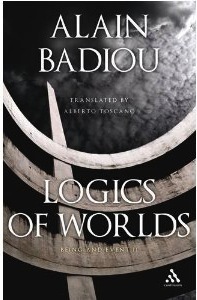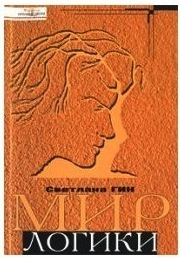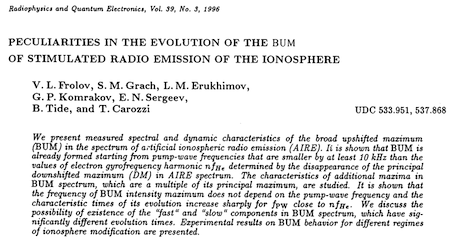Marc Abrahams's Blog, page 367
October 25, 2014
Evolution of the BUM, so they say
Some physicists cannot resist the chance to play with certain favorite words from their younger days. The title of this study is an example of what can result:
“Peculiarities in the evolution of the BUM of stimulated radio emission of the ionosphere,” V. L. Frolov, S. M. Grach, L. M. Erukhimov, G. P. Komrakov, E. N. Sergeev, B. Tide and T. Carozzi, Radiophysics and Quantum Electronics, Volume 39, Number 3, 1996, 241-254.

October 24, 2014
My recent Ig Nobel talk, at TED Talks
The talk I did recently at TEDMED is today’s talk of the day at the TED Talks site:
For more detail about any of the winners, I mention, see the full list of Ig Nobel Prize winners.

Two quick Belgian video compilations of Ig Nobel highlights
Lieven Scheire and his colleagues at Nerdland, in Belgium, produced these brief videos — compressed visual highlights from the 2014 Ig Nobel Prize ceremony webcast, and from the 2013 Ig Nobel Prize ceremony webcast:
BONUS: Lieven Scheire’s video —taken at the 2014 Ig Nobel webcast-watching party in Ghent — of Belgian Ig Nobel enthusiasts doing their own paper airplane deluge in tandem with the one happening at the Ig Nobel ceremony:

Bunkerology
Dr. Luke Bennett, a Senior Lecturer & Course Leader at the Department of the Built Environment at Sheffield Hallam University, UK, is a leading, perhaps the leading ‘Bunkerologist’. In fact it was he who created the term – meaning ‘the study of bunkers’. For a recent publication on the subject, see : ‘Who goes there? Accounting for gender in the urge to explore abandoned military bunkers’ in: Gender, Place and Culture (A Journal of Feminist Geography), Volume 20, Issue 5, 2013.
The author points out that the vast majority (though not all) bunker enthusiasts are male, and offers some ideas on why that might be the case. For example:
“From a Freudian psychoanalytic perspective, there is perhaps much that could be made of the focus, within this culture, of the shelter-as-womb and the preoccupation with penetration and return to that protective space.”
and/or possibly because of, or connected with:
“[...] a peripatetic nostalgia borne of a medley of factors: a primal urge to retreat to a place of (defensive) shelter, a nostalgia for a time where male roles had more clarity and importance (e.g. as ‘defender’), the alienation of deindustrialisation, the move away from a culture of ‘making things’ and a desire in retirement or redundancy to return to or to protect the working-life material places and artefacts that formerly gave life (and male identity) meaning.”
For further info., the author maintains a blog called ‘lukebennett13 ‘Tracing the spectacular within the humdrum of the built environment’ which features a number of bunkerological posts.
Note: Improbable apologises for the late notice regarding an event in a (somewhat) related field which is cited in the paper : Shedism. The International Men’s Sheds Festival 2014 was held October 3rd – 5th, 2014, Dublin, Ireland,
Coming soon : The testicular fortitude of urbexers
[many thanks to Dr. Bennett for his assistance]

October 23, 2014
Detecting Who Is Or Isn’t A Lie Detection Wizard
Some measure of truth is present in one or both or neither of these studies:
“On lie detection ‘wizards‘”, C.F. Bond, A. Uysal, Law and Human Behavior, 31 (2007), pp. 109–115. the authors explain:
“M. O’Sullivan and P. Ekman (2004) claim to have discovered 29 wizards of deception detection. The present commentary offers a statistical critique of the evidence for this claim. Analyses reveal that chance can explain results that the authors attribute to wizardry. Thus, by the usual statistical logic of psychological research, O’Sullivan and Ekman’s claims about wizardry are gratuitous.”
and
“The wizards of deception detection,” M. O’Sullivan, P. Ekman, in P.A. Granhag, L.A. Stromwall (Eds.), Deception detection in forensic contexts, Cambridge Press, Cambridge, UK (2004), pp. 269–286.

October 22, 2014
He was honored first for swearing, now for smiling
 Richard Stephens, who was awarded an Ig Nobel Prize for his research about swearing and pain, has just won a writing competition for his work about smiling. The Wellcome Trust reports:
Richard Stephens, who was awarded an Ig Nobel Prize for his research about swearing and pain, has just won a writing competition for his work about smiling. The Wellcome Trust reports:
Wellcome Trust Science Writing Prize 2014: The winners are…
22 OCT, 2014
The winners of the fourth Wellcome Trust Science Writing Prize were announced this evening at a ceremony held at Wellcome Trust HQ in London. With over 600 entries to choose from, picking a single winner in each category was no simple task… Split into two categories – professional scientists (postgraduate and above) and non-professionals (including undergraduates)…
the judges picked Richard Stephens and Kate Széll as this year’s winners. Richard’s piece on smiling – ‘Don’t say cheese, say cheeks’ – earned him the crown (okay, trophy!) in the professional scientists category, while Kate’s article on facial blindness entitled ‘Prosopagnosia – a common problem, commonly overlooked’ was the winner of the non-professional and undergraduate category.
Richard Stephens and two of his students (all of them at Keele University) were awarded the 2010 Ig Nobel peace prize for confirming the widely held belief that swearing relieves pain. (REFERENCE: “Swearing as a Response to Pain,” Richard Stephens, John Atkins, and Andrew Kingston, Neuroreport, vol. 20 , no. 12, 2009, pp. 1056-60.)

Atmospheric things – especially balloons
 Balloons : what do they mean to you? Harmless playthings? Medical devices? Educational tools? Or means for attending to the properties and spaces of air and geographies of atmosphere? For the latter, see the work of professor Derek McCormack, of the School of Geography and the Environment, Oxford, UK, who focusses on balloons as vehicles for conceptual and empirical experiments in the multiple space-times of atmospheric materialities. He presents a new paper in the journal Cultural Geographies, October 2014, vol. 21 no. 4 605-625. It’s entitled : ‘Atmospheric things and circumstantial excursions’
Balloons : what do they mean to you? Harmless playthings? Medical devices? Educational tools? Or means for attending to the properties and spaces of air and geographies of atmosphere? For the latter, see the work of professor Derek McCormack, of the School of Geography and the Environment, Oxford, UK, who focusses on balloons as vehicles for conceptual and empirical experiments in the multiple space-times of atmospheric materialities. He presents a new paper in the journal Cultural Geographies, October 2014, vol. 21 no. 4 605-625. It’s entitled : ‘Atmospheric things and circumstantial excursions’
“Stories told of the excursions of things are inflected by the properties of those things and by their capacities to move and be moved in different ways. Such stories can also be infused with a sense of the processes and relations from and within which these things – as apparently discrete presences – emerge. Moving in the spacetimes between these ontological and narrative imperatives, this paper tells stories of the excursions of atmospheric things as shaped forms that proposition us as discrete presences while also drawing attention to the clouds of affective and material relations in which they are generatively immersed. These episodic stories turn around the promise of the balloon as an only ever partially dirigible narrative device: a device through which to foreground what, following Michel Serres, we might call the ‘circumstantial’ qualities of atmospheric things.”
Noting as well that :
“The promise of the concept of atmospheric thing is that it points to the existence of a kind of worldly entity that makes its presence felt as something discrete but only insofar as it foregrounds the durational mattering of diffuse atmospheric fields in which it is a participant. These atmospheric things move between two trajectories in the materialisms that circulate in social, spatial and political theory. One is a growing sense of the importance of atmospheres as diffuse yet palpable spacetimes that require particular modes of attunement and genres of address. The other is the affirmation of the object as an ontological starting point whose essence is always withdrawn from the world,”
Further reading(s) :
Before embarking on any practical balloon-based explorations of atmospherics, may we recommend a document cited in the paper, namely a Pollution Policy and Position Statement from the Marine Conservation Society, UK, ‘The intentional outdoor release of balloons and Chinese/sky lanterns’ And, a Sept. 2007 story from The Daily Mail (also cited).
Also see : improbable dirigibilties in : 300,000 to 450,000 Cows Per Zeppelin, approximately.

October 21, 2014
A book no mathematician can resist?
 What mathematician could resist buying a copy of this book, after reading the bookseller’s description:
What mathematician could resist buying a copy of this book, after reading the bookseller’s description:
Logics of Worlds is the long-awaited sequel to Alain Badiou’s much-heralded masterpiece, Being and Event. Tackling the questions that had been left open by Being and Event, and answering many of his critics in the process, Badiou supplements his pioneering treatment of multiple being with a daring and complex theory of the worlds in which truths and subjects make their mark a?? what he calls a materialist dialectic.
Even many of those many critics will enjoy criticizing both the being and the event in and of this book, once they are made aware that Badiou has supplemented his pioneering treatment of multiple being with a daring and complex theory of the worlds in which truths and subjects make their mark a?? what he calls a materialist dialectic.
N’est pas?
 BONUS: They will also, perhaps, enjoy the book (the status of which, says the bookseller, is “currently unavailable”):
BONUS: They will also, perhaps, enjoy the book (the status of which, says the bookseller, is “currently unavailable”):
The world of logic. Toolkit for primary school teacher. 3rd ed / Mir logiki Metodicheskoe posobie dlya uchitelya nachalnoy shkoly – 3-e izd. – (“Biblioteka uchitelya nachalnoy shkoly “),

October 20, 2014
Trouser (pants) creases – a metrological examination
If you’re one those people who wonders about accurate trouser-crease measurement in woolen trousers (pants), you should perhaps turn to the Textile Research Journal, March 1966 36: pp. 264-272, where R.C. Landwehr (of the Western Regional Research Lab, Albany, California)
presented an apparatus and procedures to reliably measure wool creases. The ratio of maximum crease height to crease width at half height level was proposed as an objective measure of crease sharpness. See: ‘The Measurement of Wool Trouser Creases‘
“We have presented evidence to show that the subjective evaluation of creases is directly related to their objective measurements of, maximum height and sharpness, that sharpness is proportional to height, that height varies more in percent than sharpness and that height, therefore, should generally be a sensitive index of overall creases quality.“

October 19, 2014
An Ig Nobel quiz
A look back to Scossa L’Eredità (the Italian TV quiz program)’s question about the Ig Nobel Prizes:
Scossa L’Eredità 15 ottobre 2013 Laura: Premi Ignobel
BONUS: A look back at that, and several other Iggy TV quizzes

Marc Abrahams's Blog
- Marc Abrahams's profile
- 14 followers





